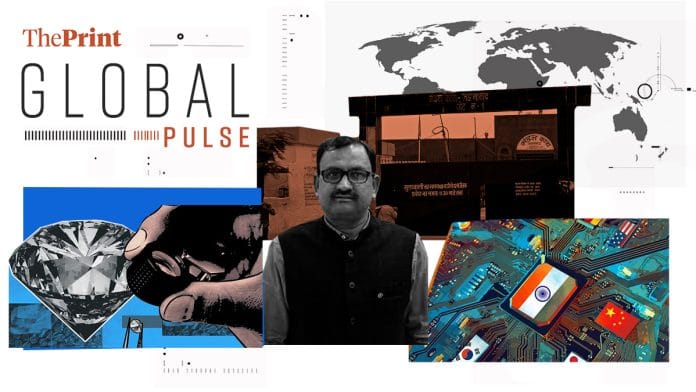New Delhi: The Russian war in Ukraine has cast a pall on several sectors in several cities across the world—and one such city is Surat, which has suddenly lost its sparkle.
The Wall Street Journal reports that Surat, India’s ‘Diamond City’, has become decidedly less shiny because of the war. India is the world’s largest exporter of polished diamonds, largely driven by Surat.
But Surat’s diamond hub status is taking a hit. “Russia’s invasion of Ukraine depressed demand for diamonds as the conflict fueled food and fuel inflation, while Western countries have sought to diminish Russia’s earnings as a way to limit its war effort,” the WSJ reports.
The American and European sanctions on Russian-owned diamond mining firm, Alrosa, account for around 30 percent of all rough diamonds in the world—and Russian diamonds account for more than 25 percent of India’s imports of rough stones.
What that means is that there are fewer diamonds for Surat’s jewellers to work with.
“Diamond traders across the town have seen sales plummet and inventories pile up, and, as a result, the hundreds of thousands of people who work as supervisors, graders, polishers and cutters across Surat are facing slashed salaries and furloughs. Some units halted operations temporarily in August,” the WSJ reports.
It’s not just Russia—conflicts in the Middle East are also affecting demands. Sales to the US and Israel have both declined. And many businessmen are concerned that continued transactions with Russia for diamonds could face repercussions from governments that have imposed sanctions.
Meanwhile, in a story on the infamous jailbreak from Bihar’s Jehanabad, the BBC paints a vivid picture of poverty, Left-wing extremism, and an overcrowded and overburdened prison system.
Describing it as Asia’s largest jailbreak, in which 389 prisoners escaped on the night of 13 November 2005, the BBC profiles the ‘mastermind’ behind it all: Ajay Kanu, or ‘Bihar’s most wanted”. A former prisoner and “rebel leader” with political ambitions, Kanu tells the BBC that he fights for poor and backward castes.
Kanu went from being a BJP member to joining the CPI(ML), slowly climbing up the underground ranks while organising Maoist groups to finally having a bounty placed on his head in 2002, when he was arrested. He spent the next three years shuttling between prisons before allegedly planning the 2005 jailbreak.
The jailbreak was over in an hour. Hundreds of rebels wearing police uniforms swam across a stream and scaled prison walls on bamboo ladders before opening fire. Prison cells were open because food was being cooked late. The rebels simply walked in while guards looked around helplessly. Prisoners—of which only 30 were convicts, whereas the other nearly 360 were awaiting trial—walked out of the gates and “disappeared into the darkness.”
“The mass jail break exposed the crumbling law and order in Bihar and the intensifying Maoist insurgency in one of India’s most impoverished regions. The rebels had timed their plan perfectly: security was stretched thin due to the ongoing state elections,” the BBC reports.
At the end of the story, the alleged mastermind finally shares an anecdote with Soutik Biswas, the BBC’s correspondent, in which a police officer asked him if he was planning another audacious escape.
“Sir, does a thief ever tell you what he’s going to steal?” the BBC reports him responding.
In a slightly less swashbuckling piece (but no less thrilling) the South China Morning Post claims that India’s semiconductor manufacturing deal with the US has predictably opened a new front—in a tech war with China.
India is “on the cusp of joining a select group of nations” that have the capabilities to manufacture front-end semiconductors, and it has the Washington-inked deal with the US to thank. A semiconductor plant is to be set up in Kolkata, which will focus on defence equipment, telecommunications and renewable energy.
“Amid rising trade tensions between Washington and Beijing, global companies are diversifying their manufacturing bases beyond China,” the South China Morning Post aptly observes. “India aims to ascend the electronics value chain to capitalise on this shift, but progress has been slow, hampered by limited domestic expertise—even as many Indian professionals contribute to advancements abroad,” it continues.
While the piece doesn’t much go into China’s feelings on the matter, it reports that analysts are optimistic about this new development—especially “as a countermeasure against China’s growing influence in the Indo-Pacific.”
The supply chain is clearly shifting away from China. And India’s now the most important link in the new chain.
The Economist seems to agree too: in a piece on how AI and globalisation is disturbing the sanguine software developers’ world, India is coming out on top.
“India is the world’s powerhouse,” it writes, when it comes to IT services. In 2023, Indian exports of software and related services were almost $200 billion, with half going to America. Indian companies have far more sophisticated offshore capabilities today, which reflects in the quality of the services and products they offer.
It’s an odd but welcome twist: large numbers of Indians were able to find a place for themselves in a burgeoning IT service sector. And now, AI and offshoring might help India—and its massive economy—get ahead of the game.
Also read: Global media on how more women in workforce could drive India’s growth story & a cheesy revolution






